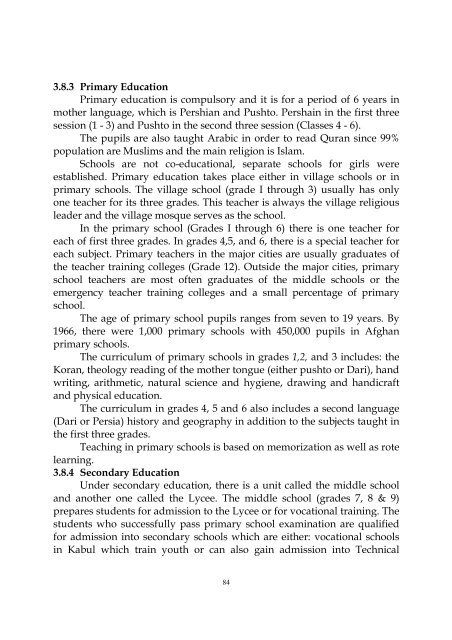edu 304 - comparative education - National Open University of Nigeria
edu 304 - comparative education - National Open University of Nigeria
edu 304 - comparative education - National Open University of Nigeria
Create successful ePaper yourself
Turn your PDF publications into a flip-book with our unique Google optimized e-Paper software.
3.8.3 Primary Education<br />
Primary <strong>edu</strong>cation is compulsory and it is for a period <strong>of</strong> 6 years in<br />
mother language, which is Pershian and Pushto. Pershain in the first three<br />
session (1 - 3) and Pushto in the second three session (Classes 4 - 6).<br />
The pupils are also taught Arabic in order to read Quran since 99%<br />
population are Muslims and the main religion is Islam.<br />
Schools are not co-<strong>edu</strong>cational, separate schools for girls were<br />
established. Primary <strong>edu</strong>cation takes place either in village schools or in<br />
primary schools. The village school (grade I through 3) usually has only<br />
one teacher for its three grades. This teacher is always the village religious<br />
leader and the village mosque serves as the school.<br />
In the primary school (Grades I through 6) there is one teacher for<br />
each <strong>of</strong> first three grades. In grades 4,5, and 6, there is a special teacher for<br />
each subject. Primary teachers in the major cities are usually graduates <strong>of</strong><br />
the teacher training colleges (Grade 12). Outside the major cities, primary<br />
school teachers are most <strong>of</strong>ten graduates <strong>of</strong> the middle schools or the<br />
emergency teacher training colleges and a small percentage <strong>of</strong> primary<br />
school.<br />
The age <strong>of</strong> primary school pupils ranges from seven to 19 years. By<br />
1966, there were 1,000 primary schools with 450,000 pupils in Afghan<br />
primary schools.<br />
The curriculum <strong>of</strong> primary schools in grades 1,2, and 3 includes: the<br />
Koran, theology reading <strong>of</strong> the mother tongue (either pushto or Dari), hand<br />
writing, arithmetic, natural science and hygiene, drawing and handicraft<br />
and physical <strong>edu</strong>cation.<br />
The curriculum in grades 4, 5 and 6 also includes a second language<br />
(Dari or Persia) history and geography in addition to the subjects taught in<br />
the first three grades.<br />
Teaching in primary schools is based on memorization as well as rote<br />
learning.<br />
3.8.4 Secondary Education<br />
Under secondary <strong>edu</strong>cation, there is a unit called the middle school<br />
and another one called the Lycee. The middle school (grades 7, 8 & 9)<br />
prepares students for admission to the Lycee or for vocational training. The<br />
students who successfully pass primary school examination are qualified<br />
for admission into secondary schools which are either: vocational schools<br />
in Kabul which train youth or can also gain admission into Technical<br />
84
















